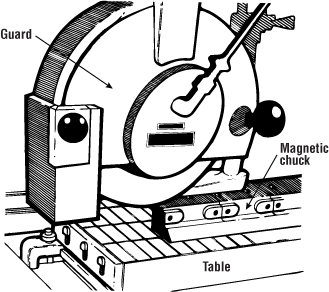Metalworking Machines - Surface Grinders
On this page
What should you know before working with a surface grinder?
Back to topA surface grinder is a tool that uses a stationary, abrasive, rotating wheel to shave or finish a metallic surface. Surface grinders can be dangerous if not used properly.
- Read the owner's manual carefully.
- Ensure that all parts, switches and plugs are in good working condition.
- Always check the grinding wheel for damage or wear before each use.
- Make sure that the material you wish to shape can be used in the grinder. Soft materials such as aluminum or brass may clog the abrasive wheel and stop the wheel from performing effectively.
- Make sure the material is securely fastened in place by a vise.
- Make sure you understand instructions and are properly trained before operating a surface grinder.
Refer to Metalworking Machines - General for basic safety tips.
Also refer to Abrasive Wheels for further information.
What are some basic safety principles to know when using a surface grinder?
Back to top- Wear appropriate CSA-certified safety glasses and other required protective equipment (including CSA-certified footwear and CSA-certified hearing protection). In addition, use the eye shield on the grinder, when provided.
- Make sure that the grinder has a working emergency start/stop button (e-stop) within easy reach of the operator.
- Check the grinding wheel before mounting it. Make sure it is properly maintained and in good working order.
- Follow the manufacturer's instructions for mounting grinding wheels.
- Keep face of the wheel evenly dressed.
- Make sure that the wheel guard covers at least one half of the grinding wheel.

- File off any burrs on the surface of work that is placed on the magnetic chuck.
- Clean the magnetic chuck with a cloth and then wipe with the palm of your hand.
- Place a piece of paper slightly larger than workpiece in the centre of chuck.
- Position work on the paper and turn on the power to the magnetic chuck.
- Check that the magnetic chuck has been turned on by trying to remove work from the chuck.
- Check that the wheel clears the work before starting the grinder.
- Run a new grinding wheel for about one minute before engaging the wheel into the work.
- Wait for the wheel to reach maximum speed before using it as there may be unseen faults in the wheel.
- Stand to one side of the wheel before starting the grinder.
- Turn off coolant before stopping the wheel to avoid creating an out-of-balance condition.
- Keep the working surface clear of scraps, tools and materials.
- Keep the floor around the grinder clean and free of oil and grease.
- Use an appropriate ventilation exhaust system to reduce inhalation of dusts, debris, and coolant mists. Exhaust systems must be designed and maintained appropriately.
- Follow lockout procedures when performing maintenance work.
What are some things you should avoid doing?
Back to top- Do not wear loose clothing or dangling jewellery as they may get caught in the moving parts of the grinder. If you have long hair, keep it tied back.
- Do not run a grinding wheel faster than the speed recommended on the wheel.
- Do not strike the wheel against the material as this action could cause faults in the wheel.
- Do not clean the magnetic chuck or mount or remove work until the wheel has completely stopped.
- Do not grind material for which wheel is not designed.
- Do not grind without proper ventilation.
- Do not start the machine until the wheel guard is in place.
- Do not stand directly in front of a grinding wheel when starting a grinder.
- Do not apply work too quickly to a cold wheel or disk.
- Do not jam work into the wheel.
- Do not reach above or around a moving wheel.
- Fact sheet last revised: 2019-01-28
